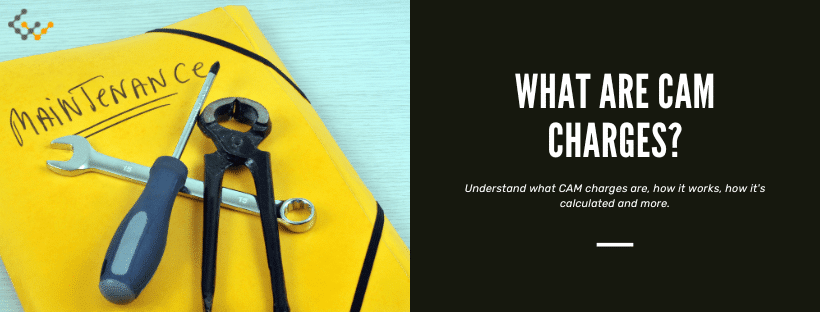What are CAM Charges?

CAM charges are a common term seen on many commercial leases and in various transactions. It refers to the expenses the property owner charges back to the tenant for maintaining the specific area described. There are many factors to consider related to CAM, and understanding how this relates to any contract or lease agreement is critical prior to entering into such an agreement. Consider what CAM is and how it may work.
What Does CAM Mean in Commercial Real Estate?
Common Area Maintenance, or CAM, is a term used to describe an agreement arranged between the parties for the management of some specific shared spaces. Many commercial spaces are shared. That means that the property is used by more than one tenant. These shared spaces are often critical components to the functionality of the commercial property.
CAM charges is the process of billing tenants for the landlord’s cost that is associated with the maintenance and upkeep of these specific shared spaces. In some situations, CAM is also referred to as expense recoveries.
Answer a few questions and get custom mortgage quotes. We'll match you with offers from our network of 650+ lenders.
Which Commercial Properties Use CAM Charges?
Not all commercial properties – or, more specifically, commercial leases – utilize the CAM charges option. Every contract should specify the requirements and expectations of maintenance for these shared spaces, though. There are some leases in which the property owner will maintain these shared spaces without sharing the cost in any way with the tenants. Other times, it may be factored into the cost of using that property.
A full-service lease typically includes a single payment made to the property owner or management company each month. The price remains the same throughout the lease term, month-to-month.
In this situation, the costs associated with any maintenance to shared spaces, along with operating costs, taxes, and utilities, are billed evenly and included within that fixed payment. In this situation, the property owner takes on the risk of paying a higher price for those costs should they rise during the contract period.
By comparison, a net lease occurs when the tenant pays CAM charges. They may also pay property-related costs that are over and above the monthly rental costs. This would lower the risks to the property owner.
Because of their structure, full-service leases tend to be more expensive than net leases.
How to Calculate CAM Charges?
To calculate CAM expenses, use the following formula:
(Square footage used by tenant / Total gross leasable area of the building) * The total CAM of the entire building.
For example, if the building has 25,000 square feet and the tenant is leasing 1,250 square feet with the total CAM for the building being $30,000, you would divide 1,250/25,000, which gives you .05 or 5% of the building. You would then take that .05 and multiply it by $30,000 to get a CAM for that tenant of $1,500.
Keep in mind there are two ways that CAM charges can be calculated. One is a fixed fee, as noted, and the second is a percentage of the total gross leasable area.
What Do CAM Charges Include?
CAM charges may include a wide range of specific costs. This is often a negotiation as a component of a lease. Typically, office spaces will include CAM charges such as:
- Water for irrigation needs
- Lighting in common areas
- Landscaping and upkeep
- Parking lot upkeep
- Sidewalks and driveway maintenance
- Stormwater management
- Electric
- Janitorial services for shared spaces
- Management and fees associated with the shared spaces
- Sewage coverage
- Window and door maintenance
In a retail establishment, most of the same CAM charges apply. In addition, they may also include:
- Administrative fees for the property
- Utility costs outside of this area
- Delivery area management and upkeep
Industrial spaces tend to have the least number of these types of charges. They may include:
- Lighting in common areas
- Water for irrigation
- Landscaping
- Parking lot maintenance
- Administrative fees
Keep in mind that each of these can be negotiated based on the objectives of all involved.
What Is Excluded from CAM Fees?
In most situations, CAM taxes will not include any costs associated with the use of the rented space. Additionally, property tax and insurance are typically not included. In many situations, commercial contracts that require the tenant to pay for property insurance and taxes will write this directly into the contract. For example, the lease may state, “CAM, Tax, and Insurance.”
Is CAM the Same as Operating Expenses?
In general, CAM and operating expenses are two terms used to describe the same overall cost. However, there are slight differences to understand.
Operating expenses are the cost of running the building. Typically, this is the overall cost – based on all costs for all tenants in the building or facility. However, CAM charges refer to the specific charge the individual property tenants, their guests, and customers will pay.
What Is CAM Reconciliation?
CAM reconciliation refers to an annual calculation that is done to determine how accurately the charges paid by the tenant reflect the actual costs. In short, this is an annual process that enables the comparison of CAM costs paid to tenant receipts.
In some situations, the CAM costs will be lower than the tenant receipts. In this situation, the company may make a distribution of that added cost to the tenant for the difference (refunding the tenant for what they paid for but did not use).
In other situations, the CAM reconciliation may show that the CAM charges were less than what the tenant used. In this situation, when an excess of cost occurs, the lease may require that the tenant pay the difference to the property owner.
There are some leaves that require CAM reconciliation on all types of shared maintenance areas. That is not always the case, though. Some property owners will not put in place these rules and may not enforce a reconciliation of costs.
In most situations, the CAM expenses are reassessed on an annual basis. However, this may be done more frequently in some situations. In very strict situations, it may be done monthly or quarterly, especially when the cost of the CAM expenses is unknown heading into the initial leasing period.
To ensure accuracy:
- CAM structures should match the functionality and costs of the property based on its use type and its overall features.
- Determine accurate square footage. To ensure that CAM charges are fair, landlords and tenants should verify that the square footage is accurately represented in the contract.
- Maintaining records is also very important. Both parties should maintain accurate records and reports to document the actual costs associated with CAM charges.
Wrapping Things Up
In many commercial leases, the CAM (common area maintenance) charges are included. This means that the tenant leasing the property is responsible for the payment of costs associated with the upkeep and maintenance of services and areas they or their customer use but also share with other tenants of that property.
Understanding the CAM charges structure of any commercial lease is essential for determining affordability and overall benefits. More so, it is critical to understand if and when reconciliation of these costs takes place to ensure there are no surprises in those costs down the road.

